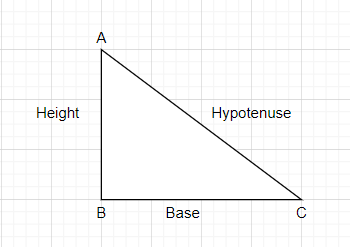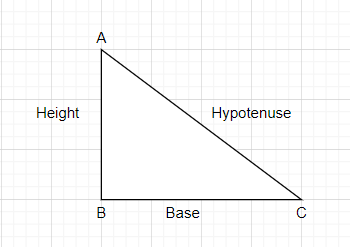
Prove the given inverse trigonometric expression, \[{{\cos }^{-1}}\left( \dfrac{4}{5} \right)+{{\cos }^{-1}}\left( \dfrac{12}{13} \right)={{\cos }^{-1}}\left( \dfrac{33}{65} \right)\] .
Answer
592.2k+ views
Hint: In this question, we have inverse cosine function in LHS as well as RHS.
To make our calculations easy which is involved in this question, we have to remove the inverse trigonometric function. We consider \[\theta ={{\cos }^{-1}}\dfrac{4}{5}\] and \[\beta ={{\cos }^{-1}}\dfrac{12}{13}\]. With the help of \[\cos \theta \] and \[\cos \beta \] , find the values of \[\sin \theta \] and \[\sin \beta \] . Then, using the formula, \[\cos \left( \theta +\beta \right)=\cos \theta \cos \beta -\sin \theta \sin \beta\] , we can solve it further.
Complete step-by-step solution -
According to the question, In LHS we have \[{{\cos }^{-1}}\left( \dfrac{4}{5} \right)+{{\cos }^{-1}}\left( \dfrac{12}{13} \right)\]…………..(1)
Let us assume,
\[\theta ={{\cos }^{-1}}\left( \dfrac{4}{5} \right)\]……………..(2)
\[\beta ={{\cos }^{-1}}\left( \dfrac{12}{13} \right)\]…………….(3)
Transforming equation (1) using equation (2) and equation (3), we get
\[{{\cos }^{-1}}\left( \dfrac{4}{5} \right)+{{\cos }^{-1}}\left( \dfrac{12}{13} \right)\]
\[=\theta +\beta\]………………(4)
Solving equation (2), we get
\[\cos \theta =\dfrac{4}{5}\]…………………(5)
Similarly, solving equation (3), we get
\[\cos \beta =\dfrac{12}{13}\]………………..(6)
In RHS we have an inverse of cosine, so we have to take cosine in equation (4).
We know the formula, \[\cos \left( \theta +\beta \right)=\cos \theta \cos \beta -\sin \theta \sin \beta\]……………(7)
From equation (5) and equation (6), we have the value of cosθ and cosβ.
But in the equation (7), we also have sinθ and sinβ.
Values of sinθ and sinβ are still unknown. So, we have to find the value of sinθ and sinβ.
We know the identity, \[{{\sin }^{2}}\theta +{{\cos }^{2}}\theta =1\] .
Solving this equation and finding sinθ in terms of cosθ, we get
\[\sin \theta =\sqrt{1-{{\cos }^{2}}\theta }\]
From equation (5), putting the value of cosθ in the above equation, we get
\[\begin{align}
& \sin \theta =\sqrt{1-\dfrac{16}{25}} \\
& \Rightarrow \sin \theta =\sqrt{\dfrac{25-16}{25}} \\
& \Rightarrow \sin \theta =\sqrt{\dfrac{9}{25}} \\
& \Rightarrow \sin \theta =\dfrac{3}{5} \\
\end{align}\]
Here The value of $\cos \theta $ is positive that means angle $\theta$ is in the first Quadrant so the value of $\sin \theta$ will be positive.
Similarly, we also have the identity, \[{{\sin }^{2}}\beta +{{\cos }^{2}}\beta =1\]
Solving this equation and finding sinβ in terms of cosβ, we get
\[\sin \beta =\sqrt{1-{{\cos }^{2}}\beta }\]
From equation (6), putting the value of cosβ in the above equation, we get
\[\begin{align}
& \sin \beta =\sqrt{1-\dfrac{144}{169}} \\
& \Rightarrow \sin \beta =\sqrt{\dfrac{169-144}{169}} \\
& \Rightarrow \sin \beta =\sqrt{\dfrac{25}{169}} \\
& \Rightarrow \sin \beta =\dfrac{5}{13} \\
\end{align}\]
Here The value of $\cos \beta $ is positive that means angle $\beta$ is in the first Quadrant so the value of $\sin \beta$ will be positive.
Now, we have got the values of sinθ and sinβ.
From equation (7), we have \[\cos (\theta +\beta )=cos\theta cos\beta -sin\theta sin\beta\]
Putting the values of cosθ, cosβ, sinθ and sinβ in the above equation, we get
\[\cos (\theta +\beta )=\dfrac{4}{5}.\dfrac{12}{13}-\dfrac{3}{5}.\dfrac{5}{13}\]
\[\begin{align}
& \cos (\theta +\beta )=\dfrac{48}{65}-\dfrac{15}{65} \\
& \Rightarrow \cos (\theta +\beta )=\dfrac{48-15}{65} \\
& \Rightarrow \cos (\theta +\beta )=\dfrac{33}{65} \\
\end{align}\]
Solving this equation, we can also write
\[\left( \theta +\beta \right)={{\cos }^{-1}}\left( \dfrac{33}{65} \right)\]
Therefore, LHS = RHS.
Hence, proved.
Note: This question can also be solved by using the Pythagoras theorem.
Assume,
\[\begin{align}
& \theta ={{\cos }^{-1}}\dfrac{4}{5} \\
& \Rightarrow \cos \theta =\dfrac{4}{5} \\
\end{align}\] --------(8)
Here we know that $\cos \theta = \dfrac{\text{Base}}{\text{Hypotenuse}} $ ----(9)
On comparing equation (8) and (9) we get base= 4 and Hypotenuse = 5
Now, using a right-angled triangle, we can get the value of \[\cos \theta \].

Using pythagoras theorem, we can find the height.
Height = \[\sqrt{{{\left( hypotenuse \right)}^{2}}-{{\left( base \right)}^{2}}}\]
\[\begin{align}
& \sqrt{{{\left( 5 \right)}^{2}}-{{4}^{2}}} \\
& =\sqrt{25-16} \\
& =\sqrt{9} \\
& =3 \\
\end{align}\]
\[\begin{align}
& sin\theta =\dfrac{\text{height}}{\text{hypotenuse}} \\
& sin\theta =\dfrac{3}{5} \\
\end{align}\]
Assume,
\[\begin{align}
& \beta ={{\cos }^{-1}}\dfrac{12}{13} \\
& \Rightarrow \cos \beta =\dfrac{12}{13} \\
\end{align}\] -------(10)
Here we know that $\cos \beta = \dfrac{\text{Base}}{\text{Height}} $ ----(11)
On comparing we get Base= 12 and Height = 13
Now, using a right-angled triangle, we can get the value of \[\cos \beta \].

Using pythagoras theorem, we can find the height.
Height = \[\sqrt{{{\left( hypotenuse \right)}^{2}}-{{\left( base \right)}^{2}}}\]
\[\begin{align}
& \sqrt{{{\left( 13 \right)}^{2}}-{{12}^{2}}} \\
& =\sqrt{169-144} \\
& =\sqrt{25} \\
& =5 \\
\end{align}\]
\[\begin{align}
& sin \beta =\dfrac{\text{height}}{\text{hypotenuse}} \\
& sin\beta =\dfrac{5}{13} \\
\end{align}\]
Using the formula, \[\cos \left( \theta +\beta \right)=\cos \theta \cos \beta -\sin \theta \sin \beta\] , it can be solved further.
To make our calculations easy which is involved in this question, we have to remove the inverse trigonometric function. We consider \[\theta ={{\cos }^{-1}}\dfrac{4}{5}\] and \[\beta ={{\cos }^{-1}}\dfrac{12}{13}\]. With the help of \[\cos \theta \] and \[\cos \beta \] , find the values of \[\sin \theta \] and \[\sin \beta \] . Then, using the formula, \[\cos \left( \theta +\beta \right)=\cos \theta \cos \beta -\sin \theta \sin \beta\] , we can solve it further.
Complete step-by-step solution -
According to the question, In LHS we have \[{{\cos }^{-1}}\left( \dfrac{4}{5} \right)+{{\cos }^{-1}}\left( \dfrac{12}{13} \right)\]…………..(1)
Let us assume,
\[\theta ={{\cos }^{-1}}\left( \dfrac{4}{5} \right)\]……………..(2)
\[\beta ={{\cos }^{-1}}\left( \dfrac{12}{13} \right)\]…………….(3)
Transforming equation (1) using equation (2) and equation (3), we get
\[{{\cos }^{-1}}\left( \dfrac{4}{5} \right)+{{\cos }^{-1}}\left( \dfrac{12}{13} \right)\]
\[=\theta +\beta\]………………(4)
Solving equation (2), we get
\[\cos \theta =\dfrac{4}{5}\]…………………(5)
Similarly, solving equation (3), we get
\[\cos \beta =\dfrac{12}{13}\]………………..(6)
In RHS we have an inverse of cosine, so we have to take cosine in equation (4).
We know the formula, \[\cos \left( \theta +\beta \right)=\cos \theta \cos \beta -\sin \theta \sin \beta\]……………(7)
From equation (5) and equation (6), we have the value of cosθ and cosβ.
But in the equation (7), we also have sinθ and sinβ.
Values of sinθ and sinβ are still unknown. So, we have to find the value of sinθ and sinβ.
We know the identity, \[{{\sin }^{2}}\theta +{{\cos }^{2}}\theta =1\] .
Solving this equation and finding sinθ in terms of cosθ, we get
\[\sin \theta =\sqrt{1-{{\cos }^{2}}\theta }\]
From equation (5), putting the value of cosθ in the above equation, we get
\[\begin{align}
& \sin \theta =\sqrt{1-\dfrac{16}{25}} \\
& \Rightarrow \sin \theta =\sqrt{\dfrac{25-16}{25}} \\
& \Rightarrow \sin \theta =\sqrt{\dfrac{9}{25}} \\
& \Rightarrow \sin \theta =\dfrac{3}{5} \\
\end{align}\]
Here The value of $\cos \theta $ is positive that means angle $\theta$ is in the first Quadrant so the value of $\sin \theta$ will be positive.
Similarly, we also have the identity, \[{{\sin }^{2}}\beta +{{\cos }^{2}}\beta =1\]
Solving this equation and finding sinβ in terms of cosβ, we get
\[\sin \beta =\sqrt{1-{{\cos }^{2}}\beta }\]
From equation (6), putting the value of cosβ in the above equation, we get
\[\begin{align}
& \sin \beta =\sqrt{1-\dfrac{144}{169}} \\
& \Rightarrow \sin \beta =\sqrt{\dfrac{169-144}{169}} \\
& \Rightarrow \sin \beta =\sqrt{\dfrac{25}{169}} \\
& \Rightarrow \sin \beta =\dfrac{5}{13} \\
\end{align}\]
Here The value of $\cos \beta $ is positive that means angle $\beta$ is in the first Quadrant so the value of $\sin \beta$ will be positive.
Now, we have got the values of sinθ and sinβ.
From equation (7), we have \[\cos (\theta +\beta )=cos\theta cos\beta -sin\theta sin\beta\]
Putting the values of cosθ, cosβ, sinθ and sinβ in the above equation, we get
\[\cos (\theta +\beta )=\dfrac{4}{5}.\dfrac{12}{13}-\dfrac{3}{5}.\dfrac{5}{13}\]
\[\begin{align}
& \cos (\theta +\beta )=\dfrac{48}{65}-\dfrac{15}{65} \\
& \Rightarrow \cos (\theta +\beta )=\dfrac{48-15}{65} \\
& \Rightarrow \cos (\theta +\beta )=\dfrac{33}{65} \\
\end{align}\]
Solving this equation, we can also write
\[\left( \theta +\beta \right)={{\cos }^{-1}}\left( \dfrac{33}{65} \right)\]
Therefore, LHS = RHS.
Hence, proved.
Note: This question can also be solved by using the Pythagoras theorem.
Assume,
\[\begin{align}
& \theta ={{\cos }^{-1}}\dfrac{4}{5} \\
& \Rightarrow \cos \theta =\dfrac{4}{5} \\
\end{align}\] --------(8)
Here we know that $\cos \theta = \dfrac{\text{Base}}{\text{Hypotenuse}} $ ----(9)
On comparing equation (8) and (9) we get base= 4 and Hypotenuse = 5
Now, using a right-angled triangle, we can get the value of \[\cos \theta \].

Using pythagoras theorem, we can find the height.
Height = \[\sqrt{{{\left( hypotenuse \right)}^{2}}-{{\left( base \right)}^{2}}}\]
\[\begin{align}
& \sqrt{{{\left( 5 \right)}^{2}}-{{4}^{2}}} \\
& =\sqrt{25-16} \\
& =\sqrt{9} \\
& =3 \\
\end{align}\]
\[\begin{align}
& sin\theta =\dfrac{\text{height}}{\text{hypotenuse}} \\
& sin\theta =\dfrac{3}{5} \\
\end{align}\]
Assume,
\[\begin{align}
& \beta ={{\cos }^{-1}}\dfrac{12}{13} \\
& \Rightarrow \cos \beta =\dfrac{12}{13} \\
\end{align}\] -------(10)
Here we know that $\cos \beta = \dfrac{\text{Base}}{\text{Height}} $ ----(11)
On comparing we get Base= 12 and Height = 13
Now, using a right-angled triangle, we can get the value of \[\cos \beta \].

Using pythagoras theorem, we can find the height.
Height = \[\sqrt{{{\left( hypotenuse \right)}^{2}}-{{\left( base \right)}^{2}}}\]
\[\begin{align}
& \sqrt{{{\left( 13 \right)}^{2}}-{{12}^{2}}} \\
& =\sqrt{169-144} \\
& =\sqrt{25} \\
& =5 \\
\end{align}\]
\[\begin{align}
& sin \beta =\dfrac{\text{height}}{\text{hypotenuse}} \\
& sin\beta =\dfrac{5}{13} \\
\end{align}\]
Using the formula, \[\cos \left( \theta +\beta \right)=\cos \theta \cos \beta -\sin \theta \sin \beta\] , it can be solved further.
Recently Updated Pages
Master Class 12 Business Studies: Engaging Questions & Answers for Success

Master Class 12 Economics: Engaging Questions & Answers for Success

Master Class 12 English: Engaging Questions & Answers for Success

Master Class 12 Maths: Engaging Questions & Answers for Success

Master Class 12 Social Science: Engaging Questions & Answers for Success

Master Class 12 Chemistry: Engaging Questions & Answers for Success

Trending doubts
What are the major means of transport Explain each class 12 social science CBSE

Which are the Top 10 Largest Countries of the World?

Draw a labelled sketch of the human eye class 12 physics CBSE

How much time does it take to bleed after eating p class 12 biology CBSE

Explain sex determination in humans with line diag class 12 biology CBSE

Differentiate between homogeneous and heterogeneous class 12 chemistry CBSE




